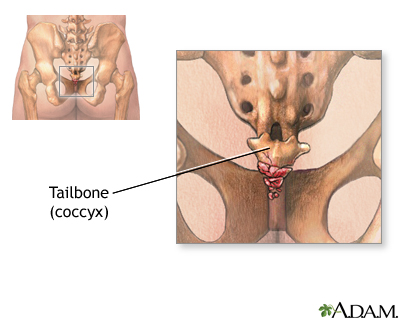Health Library
Tailbone trauma
Coccyx injury
Tailbone trauma is an injury to the small bone at the lower tip of the spine.
Images

I Would Like to Learn About:
Considerations
Actual fractures of the tailbone (coccyx) are not common. Tailbone trauma usually involves bruising of the bone or pulling of the ligaments.
Causes
Backward falls onto a hard surface, such as a slippery floor or ice, are the most common cause of this injury.
Symptoms
Symptoms include:
- Bruising on the lower part of the spine
- Pain when sitting or putting pressure on the tailbone
First Aid
For tailbone trauma when no spinal cord injury is suspected:
- Relieve pressure on the tailbone by sitting on an inflatable rubber ring or cushions.
- Take acetaminophen (Tylenol) or ibuprofen (Advil, Motrin IB) for pain.
- Take a stool softener to avoid constipation.
If you suspect injury to the neck or spine, DO NOT attempt to move the person.
Do Not
DO NOT attempt to move the person if you think there may be injury to the spinal cord.
When to Contact a Medical Professional
Call 911 or the local emergency number for immediate medical help if:
- Spinal cord injury is suspected
- The person can't move
- Pain is severe
Prevention
Keys to preventing tailbone trauma include:
- DO NOT run on slippery surfaces, such as around a swimming pool.
- Dress in shoes with good tread or slip-resistant soles, especially in snow or on ice.
Related Information
Broken boneBleeding into the skin
References
Bond MC, Abraham MK. Pelvic injuries. In: Walls RM ed. Rosen's Emergency Medicine: Concepts and Clinical Practice. 10th ed. Philadelphia, PA: Elsevier; 2023:chap 46.
Vora A, Chan S. Coccydynia. In: Frontera WR, Silver JK, Rizzo TD Jr, eds. Essentials of Physical Medicine and Rehabilitation: Musculoskeletal Disorders, Pain, and Rehabilitation. 4th ed. Philadelphia, PA: Elsevier; 2019:chap 99.
BACK TO TOPReview Date: 2/8/2024
Reviewed By: Linda J. Vorvick, MD, Clinical Professor, Department of Family Medicine, UW Medicine, School of Medicine, University of Washington, Seattle, WA. Also reviewed by David C. Dugdale, MD, Medical Director, Brenda Conaway, Editorial Director, and the A.D.A.M. Editorial team.
 | A.D.A.M., Inc. is accredited by URAC, for Health Content Provider (www.urac.org). URAC's accreditation program is an independent audit to verify that A.D.A.M. follows rigorous standards of quality and accountability. A.D.A.M. is among the first to achieve this important distinction for online health information and services. Learn more about A.D.A.M.'s editorial policy, editorial process and privacy policy. A.D.A.M. is also a founding member of Hi-Ethics. This site complies with the HONcode standard for trustworthy health information: verify here. |
The information provided herein should not be used during any medical emergency or for the diagnosis or treatment of any medical condition. A licensed medical professional should be consulted for diagnosis and treatment of any and all medical conditions. Links to other sites are provided for information only -- they do not constitute endorsements of those other sites. No warranty of any kind, either expressed or implied, is made as to the accuracy, reliability, timeliness, or correctness of any translations made by a third-party service of the information provided herein into any other language. © 1997- 2025 A.D.A.M., a business unit of Ebix, Inc. Any duplication or distribution of the information contained herein is strictly prohibited.
